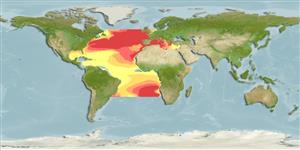Teleostei (teleosts) >
Myctophiformes (Lanternfishes) >
Myctophidae (Lanternfishes) > Myctophinae
Etymology: Symbolophorus: Greek, symbolon, ou = mark, signal + Greek, pherein = to carry (Ref. 45335).
Eponymy: Chevalier Jean Baptiste Vérany (1800–1865) was a French naturalist and pharmacist. [...] (Ref. 128868), visit book page.
Environment: milieu / climate zone / depth range / distribution range
Ecology
Marine; bathypelagic; oceanodromous (Ref. 51243); depth range 0 - 800 m (Ref. 4479). Deep-water; 55°N - 26°S, 82°W - 36°E
Eastern Atlantic: Iceland (strays) and British Isles to Western Sahara including the Mediterranean. Western Atlantic: Nunavut and USA to Brazil in slope water region.
Length at first maturity / Size / Weight / Age
Maturity: Lm ?, range 9 - ? cm
Max length : 12.5 cm TL male/unsexed; (Ref. 128245); max. published weight: 21.30 g (Ref. 126117)
High-oceanic species found at 550-700 m during the day and nyctoepipelagic at the surface and down to 800 m (maximum abundance at the surface) (Ref. 4479). Epipelagic to bathypelagic (Ref. 58426). Size stratification with depth at night, with small sub-adults deeper than large sub-adults and adults (Ref. 4775). Feeds on crustaceans (Ref. 58426).
Life cycle and mating behavior
Maturity | Reproduction | Spawning | Eggs | Fecundity | Larvae
Hulley, P.A., 1990. Myctophidae. p. 398-467. In J.C. Quero, J.C. Hureau, C. Karrer, A. Post and L. Saldanha (eds.) Check-list of the fishes of the eastern tropical Atlantic (CLOFETA). JNICT, Lisbon; SEI; Paris; and UNESCO, Paris. Vol. 1. (Ref. 4479)
IUCN Red List Status (Ref. 130435: Version 2024-1)
Threat to humans
Harmless
Human uses
Tools
Special reports
Download XML
Internet sources
Estimates based on models
Preferred temperature (Ref.
123201): 9.8 - 16, mean 13.2 °C (based on 303 cells).
Phylogenetic diversity index (Ref.
82804): PD
50 = 0.5039 [Uniqueness, from 0.5 = low to 2.0 = high].
Bayesian length-weight: a=0.00776 (0.00434 - 0.01389), b=3.08 (2.93 - 3.23), in cm total length, based on LWR estimates for this species & (Sub)family-body (Ref.
93245).
Trophic level (Ref.
69278): 3.3 ±0.38 se; based on food items.
Resilience (Ref.
120179): High, minimum population doubling time less than 15 months (Preliminary K or Fecundity.).
Fishing Vulnerability (Ref.
59153): Low vulnerability (10 of 100).
Nutrients (Ref.
124155): Calcium = 73.6 [22.2, 220.4] mg/100g; Iron = 0.518 [0.192, 1.651] mg/100g; Protein = 17 [15, 19] %; Omega3 = 0.47 [0.16, 1.41] g/100g; Selenium = 11.3 [3.6, 34.1] μg/100g; VitaminA = 93 [12, 787] μg/100g; Zinc = 0.787 [0.393, 1.701] mg/100g (wet weight);
